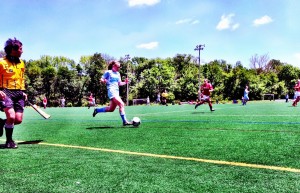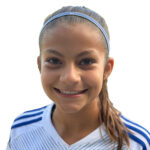Our unhealthy obsession with childhood athletic success
 From the Little League World Series to “American Idol,” we have an unhealthy obsession with ‘discovering’ the next generation of great youth talent in this country. This is especially true when it comes to sports.
From the Little League World Series to “American Idol,” we have an unhealthy obsession with ‘discovering’ the next generation of great youth talent in this country. This is especially true when it comes to sports.
I am not saying it is bad to identify talent. Our problem lies in how we define talent at the youngest ages, how and when we select it, and what we do with our newly discovered “talent.” Unfortunately, our current system often de-emphasizes all the things that might one day allow true talent to shine, and successful young athletes to become elite adult competitors.
Our first problem lies in how we define talent. We sort our youth sports system chronologically, based upon arbitrary calendar cutoffs. As a result, when we start selecting all stars at ages seven and up, research has shown that most kids selected are born within three months of the calendar cutoff date. In other words, we are selecting kids who are older and more physically mature, who can run faster, jump higher, and do all the athletic things a little bit better then the younger kids because of their relative age. The “talent” has very little to do with sport-specific skill, and far more to do with age and physical maturity.
As an example, an 8-year-old born in January, playing a sport that has a January 1 cutoff date, is 12% older than a kid born in December of the same year, even though they are in the same age group. This is a massive difference. These kids may be chronologically the same age according to their sports league, but often they are developmentally light years apart.
Who gets picked? The research of Canadian psychologist Roger Barnsley on junior hockey players shows us that in this scenario the children born January through March are five times more likely to be selected than those born in November or December! We are not identifying talent; we are identifying relative age.
The second issue is how and when we select talent. We have a downward creep in our country, meaning every time we decide to start having tryouts at one age, we begin to organize kids a year younger. If we have tryouts at U11, then we start collecting and culling the U10s. Pretty soon, we say “why not just start tryouts at U10,” and then start sorting the U9s. We start making cuts at increasingly younger ages, and tell a slew of kids that they are not talented by cutting them from the select team. As mentioned above, the greatest predictor of whether a child will make the team or not at these young ages is his of her month of birth!
To make it even worse, often this cutting is not done by highly trained, independent evaluators, but by moms and dads who are coaching, and have a child in the player pool. You think they are going to cut their own kid? And even when we have qualified talent evaluators, again, we are excluding far too many potential players at a time when the biggest difference between two kids might be their relative age and a few months additional coaching. Finally, let’s be honest and admit that we are selecting athletes who are likely to help us win now, with little regard to who might be the better player years from now.
This leads us to the third issue, the over-emphasis of winning with our newly discovered elite athletes. After selecting our “talented’ kids, we then funnel a select few into systems with better resources, better coaching and better competition, and exclude others. We travel further and further for games, start measuring development by wins and losses. Once this is established, coaches inevitably play the kids who are going to help them win.
 Let’s take a soccer coach who has 14 families of 10-year-olds paying $1000-plus per year for training as an example. If he wants to keep his job at most clubs, he better beat the local town team with the volunteer coach, or the neighboring club that only charges $400 in fees. But what if the other team has a man-child forward who can run by everyone, a man-child defender or goalkeeper who can kick it over everyone’s head, and a coach who screams at everyone to kick it long?
Let’s take a soccer coach who has 14 families of 10-year-olds paying $1000-plus per year for training as an example. If he wants to keep his job at most clubs, he better beat the local town team with the volunteer coach, or the neighboring club that only charges $400 in fees. But what if the other team has a man-child forward who can run by everyone, a man-child defender or goalkeeper who can kick it over everyone’s head, and a coach who screams at everyone to kick it long?
The coach trying to teach his players to actually play soccer, to pass it around the back, to use skill instead of athleticism, will likely lose this game if he does not possess his own ultra-fast, growing man-children. If he has them, in order to get a result he benches his smaller kids because “they cannot compete” with the big kids that day, and thus he keeps happy the parents of the 10 or so more athletically developed kids. Or, he plays everyone, loses, and deals with the grumbling parents who cannot understand why they pay so much to lose. Never mind the fact that if the coach is developing his players correctly, his team will win that same game 10 times out of 10 in a few years when athleticism is equal, and technique matters more. We ignore that. We have stopped thinking long-term.
This is problematic because at these youngest ages, sports is supposed to be about providing enjoyable activities for children, AND prioritizing the development of future players over the performance of current ones. As noted speaker, author and former NBA player Bob Bigelow says, “All 6th grade basketball players stink. The best player stinks, and the rest just stink worse, but they all stink.”
What he means is that aggrandizing young players who cannot adequately shoot, pass, dribble or defend is incredibly shortsighted. Selecting all star teams and cutting kids prior to puberty does not identify the players with the most future potential; it identifies the players that are often a little older, a little more physically mature, and perhaps have a bit more skill then the ones you cut.
This can be psychologically damaging as well. Many young athletes often identify their worth in the eyes of their parents, coaches and peers in terms of sports achievement. “Johnny the great soccer player,” or “Mary the best swimmer” learn to tie their identity to their athletic success. This is great until everyone else grows, the physical differences disappear, and athletes realize that you actually need skill and desire to be successful.
Many young stars never learned to work hard, never faced adversity or a challenge for their spot on the team, and never developed the proper techniques needed to succeed at the adult version of their game. They were the star; now they can no longer compete. It’s psychologically traumatic for a 12-year-old whose name was called on ESPN Sportscenter to get cut from the high school varsity, and replaced by the kid who got cut from his Little League team, but it happens. And once they stop succeeding in sport, their self-esteem and worth plummets.
If we want to develop athletes for the long run, we need to make some changes. We have to get away from our ESPN “Little League World Series” culture that is hurting more kids than it is helping. Here are a few thoughts on how to do this:
 1. We need to stop trying to identify future talent so young. We have to stop cutting kids at Under-9 to U-12, and thus give larger numbers of athletes’ access to trained coaching, facilities and resources. We have to allow them to develop at their own pace. We need in house, academy-style programs at youth sports clubs at least through U12, developing large numbers of players, emphasizing training over games, and focusing on local, small sided competition instead of travel ball.
1. We need to stop trying to identify future talent so young. We have to stop cutting kids at Under-9 to U-12, and thus give larger numbers of athletes’ access to trained coaching, facilities and resources. We have to allow them to develop at their own pace. We need in house, academy-style programs at youth sports clubs at least through U12, developing large numbers of players, emphasizing training over games, and focusing on local, small sided competition instead of travel ball.
2. We must stop focusing on winning, rankings, etc. for our teams prior to high school. We need parents who demand that coaches develop their kids, and coaches who demand that they be allowed to develop them appropriately. It is time for youth sports organizations to take a stand, to say “The customer is NOT always right” and do right by the kids and not the parents. Very few are doing this right now, because there is always competitor willing to focus on wins and attract families who do not know any better.
3. After their growth spurt, from middle school through high school, we can start selecting out the truly talented, dedicated, and elite athletes, as age becomes less of a factor. By doing this, we can get rid of our detrimental system that identifies players far too young, for the wrong things, one that funnels many kids out of the proper development system, and funnels the better ones into high pressure, win at all costs clubs that injures or burns out most of them by high school.
Our current system is killing our young athletes’ enthusiasm and love of sports. Our identification and celebration of success at a young age, with its accompanying creature comforts and media exposure, has created a legion of doting fans of pre-pubescent athletes, before those kids have actually accomplished anything at all in sports. These young “stars” burn brightly, and then often burn out before high school.
And what of the players who might truly have talent but grew later than their peers, the ones who could take their place and become elite high school, college, and perhaps even professional players? Well, we cut them years ago, because they weren’t good enough to help us win the statewide U-10 “Ultra Awesome Super Duper Cup Championship” that we trained all year for.
We can do better!
SOCCERWIRE MARKETPLACE
- The St. James FC Virginia 2024-2025 Travel Tryouts
- TSJFCV - Hiring Travel Soccer Coaches
- Hiring: U13-U19 Boys Director
- Coaches Needed
- Train with professional AC Milan coach
- Loudoun Soccer 2024/25 Travel Player Placement Sessions
- Official Elite Summer Soccer Camps with Elite Pro Clubs in Europe
- Official EPL Tickets: ARSENAL, LIVERPOOL, TOTTENHAM & MORE
- Travel to Denmark for Dana Cup Hjørring 2024
- New England Surf Challenge and Showcase 2024












